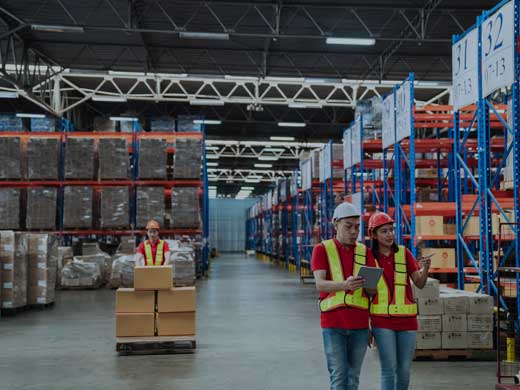Rethink the way you operate: that’s the message the world is sending every business owner in the food and beverage (FB) sector.
Like your competitors, you’re battling inflationary prices for raw materials, labour, and energy while striving to keep tight margins from shrinking further.
Meanwhile, your supply chain is disrupted regularly by natural and man-made disasters.
If the business seems less fun, it’s good to know that digital technology can help you address these challenges and support your goals for building a thriving business.
In the following discussion, we highlight five key ways CEOs are taking action in this disruptive environment. In all these courses of action, you’ll note that a digital transformation is a must.
These FB companies took on the multifaceted challenges of digital transformation because it was the most cost-efficient way to meet their business goals.
For an introduction to the key elements of digital transformation, read our article, “14 Essential ERP Questions to Ask When Your Growing Business is Set on Digital Transformation.”
1. Reduce the pressures of the labour shortage with technology

For many companies, finding the right people in a tight labour market is a top priority. Wage increases have only added to the degree of difficulty for HR recruiters.
That’s where digital technology, like automation, robotics, or software can reduce the pressure to recruit workers by dramatically elevating your productivity, improving quality, and reducing errors.
Such tools can make physical tasks easier and work more appealing by reducing routine elements. In the FB industry, where numerous companies are still carrying out manual tasks that add little if any value, this technology can liberate your team so it can focus on work that adds more value to your bottom line.
How your technology impacts talent management
Remember, younger workers are more likely to have digital skills and prioritize them as they evaluate the employers they want to work for.
When employees and job candidates see that your company uses technology to advantage, you benefit from a halo effect on your employer brand. This halo effect makes it easier to attract and retain the talent you want in your business.
It’s true, though, that workers qualified to use the latest technology are harder to find in Canada.
How management thinks about technology
Another potential obstacle to address may be your executive team’s reluctance to invest in digital technology, due to bad experiences or a lack of awareness of the benefits.
We highly recommend that you have qualified executives to build a business case for the relevant digital technology. Your team may be pleasantly surprised by the business benefits they’re letting go by.
Remember, the federal and provincial governments are receptive to helping growing businesses innovate through technology. Their financial support may be just the helping hand you need to take your business to the next level.
An ERP system can make a big difference in how you address the labour shortage. Read our post, “6 Ways Your Food and Beverage Business Can Navigate the Labor Shortage with an ERP System.”
2. Focus on real-time data to make better decisions

Many FB companies have plants, technology, and other physical assets that lag behind the times. The same is true for their access to reliable, real-time data about business performance.
For example, a great number of FB businesses still use paper-based tools and software siloed in various business functions. Because these silos don’t communicate with each other, retrieving data for decision-making is a slow, laborious process. What’s more, the data is often polluted with inaccuracies, duplications, and incompletions — to name only a few issues.
How sound or agile can your decision be when it’s founded on such data?
There’s no need to run your business this way when you can access real-time data and 360-degree visibility into all your operations.
Cloud-based Enterprise Resource Planning (ERP) systems are now common among forward-thinking FB businesses. As the backbone of a digital transformation, ERPs also empower you to integrate other digitally based, productivity-enhancing tools, such as robotics, artificial intelligence (AI), and 3D printing.
Learn more about the benefits of real-time data in our article, “5 Ways the Real-Time Data of Your ERP Reduces Risk and Cost.”
3. Add flexibility to your supply chain

The first step to improving your flexibility of response is to improve visibility into your supply chain. Through digital technology (e.g., EDI), both suppliers and customers gain real-time transparency into the levels of raw materials, components, and orders in their ecosystem. Adding analytics and forecasting modules to your toolkit further enhances your capacity to plan and make decisions. Thus, potential supply issues can be detected at an earlier stage, which gives your team more time to remedy the situation.
The IoT delivers new levels of transparency
As the IoT (Internet of Things) gains traction, visibility into your supply chain will go up a level. For example, sensors in your equipment will be sharing data about their activity with all digital devices connected to them, so you’ll know in real time how your equipment is performing.
Similarly, tracking devices placed in your shipments can update you in real time on the location of the shipment, the temperature of the environment, and other factors important to safe, timely shipments.
But as discussed, the first step to gaining the flexibility and peace of mind these digital tools provide means undertaking a digital transformation, with an ERP system as the backbone of your operation.
Discover more ways ERP software can help you address supply chain challenges in our article, “4 Food and Beverage Supply Chain Challenges that ERP Software Can Help You Overcome.”
4. Prioritize efficiency and waste reduction

While efficiency and waste reduction are always top of mind for a business owner, an era of inflationary pricing makes alarm bells ring around these concerns.
Inventory, for example, can be a sinkhole of costs if not managed efficiently. But with the right ERP system, your inventory management module enables you to automatically determine what the optimal inventory mix should be and what minimum and maximum quantities to maintain by season.
For example, the analytics supporting this feature allow you to identify goods that have the following:
i) the highest annual consumption value
ii) average consumption value
iii) the lowest consumption value
With this data in hand, you can make purchasing and production decisions that are more aligned with your past performance. This level of inventory management saves you money and improves your capacity for responding to customer demand.
What SCADA can do for you
Supervisory control and data acquisition (SCADA) systems combine hardware and software components so you can control industrial processes remotely.
At the same time, you can monitor and gather data on how the machines are performing. With this data, you can make better decisions while ensuring your equipment works optimally to reduce downtime, food waste, and unnecessary maintenance.
AI, machine learning, and robotics to the rescue
With mountains of business data to comb through, you can use AI and machine learning to gain insights into questions such as these: What are the best conditions for reducing food waste? How can we extend the shelf life of products? Under what conditions does our equipment perform better?
Robots are increasingly making their presence felt in the FB industry. The right robot, for example, may be able to reduce the unnecessary waste of your packaging process.
Stressed by the challenges of inventory management? Read our article, “5 Ways ERP Inventory Management Levels Up Your Business.”
5. Embrace sustainability to meet customer demand and profitability goals

Consumers are voting with their wallets for sustainable products. This demand presents FB companies with business-building opportunities in sales and operations.
On the sales side, for example, a sustainable product may give you an advantage over competitors while also meeting the needs of customers.
In plant operations, your sustainability goals can help drive your team to be more efficient with energy, water, waste, and the carbon footprint. As a result, sustainability measures help enhance profitability.
To pursue sustainability measures, though, you need precise real-time data about how your business is performing. When your company’s processes are supported by digital technology, you’re empowered to apply the technologies of smart manufacturing (i.e., computer-integrated) to create a more sustainable and efficient business.
To learn more about how shoppers are impacting the FB industry, read our article, “5 Consumer Trends in the Food and Beverage Industry.”
As an FB business owner, you’ll always have to contend with the classic business pressures of cost, quality, and efficiency. Unfortunately, today’s natural and man-made disruptions only increase the degree of difficulty surrounding the decisions you have to make every day.
But with the right digital tools, you’ll be empowered to make better decisions faster and equip your team with greater resilience and agility to face whatever business challenges you face.
Connect with us to get answers to your questions or benefit from a personalized demo.





